
Cod is the common name for the demersal fish genus Gadus, belonging to the family Gadidae. Cod is also used as part of the common name for a number of other fish species, and one species that belongs to genus Gadus is commonly not called cod.

Mackerel is a common name applied to a number of different species of pelagic fish, mostly from the family Scombridae. They are found in both temperate and tropical seas, mostly living along the coast or offshore in the oceanic environment.

Sardine and pilchard are common names for various species of small, oily forage fish in the herring family Clupeidae. The term 'sardine' was first used in English during the early 15th century; a somewhat dubious folk etymology says it comes from the Italian island of Sardinia, around which sardines were once supposedly abundant.

The Greenland cod, commonly known also as ogac, is a species of ray-finned fish in the cod family, Gadidae. Genetic analysis has shown that it may be the same species as the Pacific cod. It is a bottom-dwelling fish and is found on the continental shelf in the Arctic Ocean and northwestern Atlantic Ocean, its range extending from Alaska to West Greenland, then southwards along the Canadian coast to the Gulf of St. Lawrence and Cape Breton Island. It is a commercially harvested food fish, but landings have been greatly reduced in recent years.

The Pacific cod is a species of ray-finned fish in the family Gadidae. It is a bottom-dwelling fish found in the northern Pacific Ocean, mainly on the continental shelf and upper slopes, to depths of about 900 m (3,000 ft). It can grow to a length of a meter or so and is found in large schools. It is an important commercial food species and is also known as gray cod or grey cod, and grayfish or greyfish. Fishing for this species is regulated with quotas being allotted for hook and line fishing, pots, and bottom trawls. Fossils have been found in Canada near a Steller Sea lion fossil dating to the Pleistocene.

Gadus is a genus of demersal fish in the family Gadidae, commonly known as cod, although there are additional cod species in other genera. The best known member of the genus is the Atlantic cod.
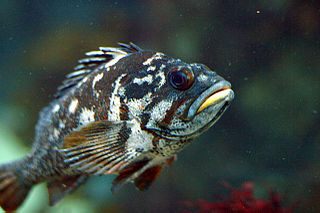
Sebastinae is a subfamily of marine fish belonging to the family Scorpaenidae in the order Scorpaeniformes. Their common names include rockfishes, rock perches, ocean perches, sea perches, thornyheads, scorpionfishes, sea ruffes and rockcods. Despite the latter name, they are not closely related to the cods in the genus Gadus, nor the rock cod, Lotella rhacina.

Sprat is the common name applied to a group of forage fish belonging to the genus Sprattus in the family Clupeidae. The term also is applied to a number of other small sprat-like forage fish. Like most forage fishes, sprats are highly active, small, oily fish. They travel in large schools with other fish and swim continuously throughout the day.
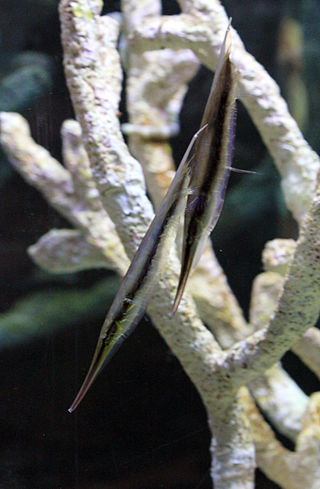
The Centriscidae are a family of fishes from the order Syngnathiformes which includes the snipefishes, shrimpfishes, and bellowfishes. A small family, consisting of only about a dozen marine species, they are of an unusual appearance, as reflected by their common names. The species in this family are restricted to relatively shallow, tropical parts of the Indo-Pacific.

Snipe eels are a family, Nemichthyidae, of eels that consists of nine species in three genera. They are pelagic fishes, found in every ocean, mostly at depths of 300–600 m (980–1,970 ft) but sometimes as deep as 4,000 m (13,000 ft). Depending on the species, adults may reach 1–2 m (39–79 in) in length, yet they weigh only 80–400 g (2.8–14.1 oz). They are distinguished by their very slender jaws that separate toward the tips as the upper jaw curves upward. The jaws appear similar to the beak of the bird called the snipe. Snipe eels are oviparous, and the juveniles, called Leptocephali, do not resemble the adults but have oval, leaf-shaped and transparent bodies. Different species of snipe eel have different shapes, sizes and colors. The similarly named bobtail snipe eel is actually in a different family and represented by two species, the black Cyema atrum and the bright red Neocyema erythrosoma.

The long-finned pike or yellowfin pike is a species of perciform fish, the only species in the genus Dinolestes, as well as the family Dinolestidae.
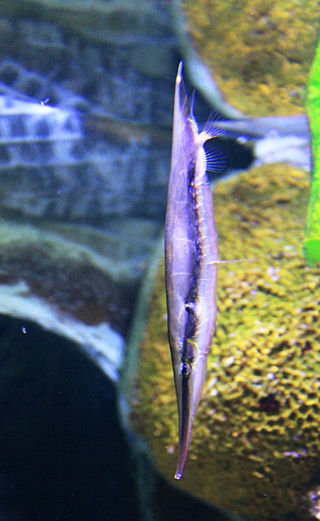
Aeoliscus strigatus, also known as the razorfish, jointed razorfish or coral shrimpfish, is a member of the family Centriscidae of the order Syngnathiformes. This unique fish adopts a head-down tail-up position as an adaptation for hiding among sea urchin spines. The razorfish is found in coastal waters in the Indo-West Pacific. Its natural habitat includes beds of sea grass and coral reefs, where sea urchins are found.

An anchovy is a small, common forage fish of the family Engraulidae. Most species are found in marine waters, but several will enter brackish water, and some in South America are restricted to fresh water.
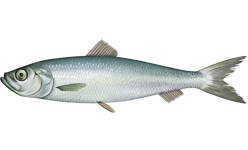
Clupea is genus of planktivorous bony fish belonging to the family Clupeidae, commonly known as herrings. They are found in the shallow, temperate waters of the North Pacific and the North Atlantic oceans, including the Baltic Sea. Two main species of Clupea are currently recognized: the Atlantic herring and the Pacific herring, which have each been divided into subspecies. Herrings are forage fish moving in vast schools, coming in spring to the shores of Europe and America, where they form important commercial fisheries.

Aeoliscus is a genus of shrimpfishes found in the Indian and Pacific Oceans.
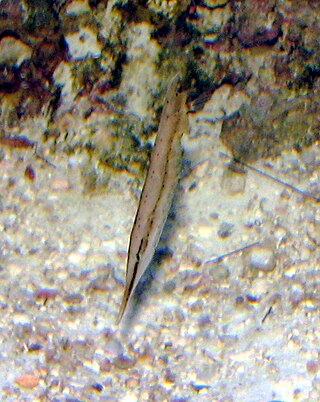
Aeoliscus punctulatus, also known as the speckled shrimpfish or jointed razorfish, is a member of the family Centriscidae of the order Syngnathiformes. This fish adopts a head-down, tail-up position as an adaptation for hiding among sea urchin spines. This fish is found in coastal waters in the Indo-West Pacific. Its natural habitat includes beds of seagrass and coral reefs, where sea urchins are found.

Pentapodus nagasakiensis, the Japanese whiptail or Japanese butterfish, is a species of marine fish in the coral bream family (Nemipteridae) of order Perciformes. It is native to the western Pacific Ocean.
Centriscus cristatus, also known as the smooth razorfish or wafer shrimpfish, is the largest member of the family Centriscidae of the order Syngnathiformes. It is found in the eastern Indian Ocean and the western Pacific Ocean.
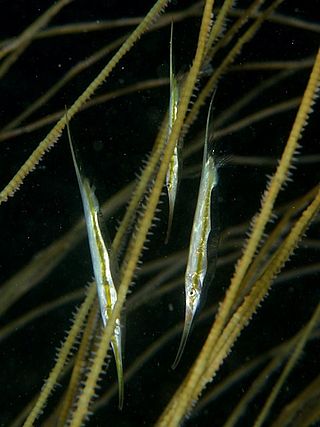
Centriscus scutatus is a slender fish that reaches a length of 15 cm (5.9 in). It is found at depth between 2 and 333 m in the Indian and Pacific oceans, from the Red Sea and Persian Gulf up to Japan, New Caledonia and Australia. This coastal species inhabits mud or silty sand next to sea grasses or corals. It swims almost vertically, sometimes in large groups, with head pointed downwards, and feeds on small crustaceans.
Parotocinclus cristatus is a species of catfish in the family Loricariidae. It is native to South America, where it is known from coastal rivers near Ilhéus in the state of Bahia in Brazil. The species reaches 4 centimeters (1.6 in) in total length.




















